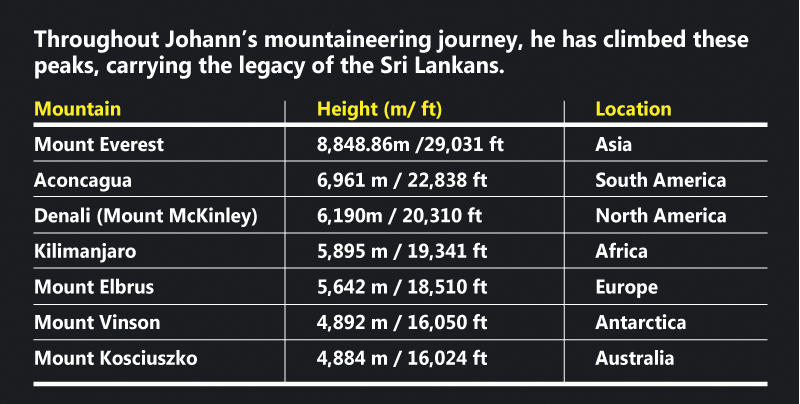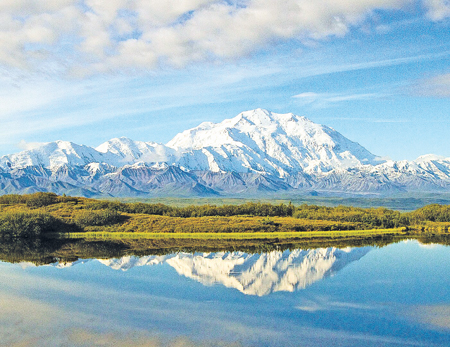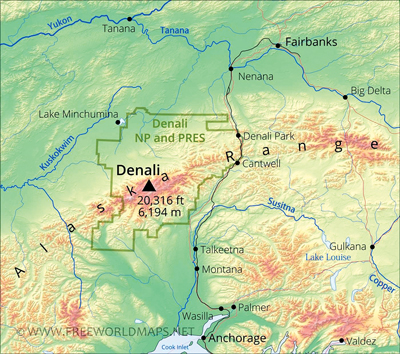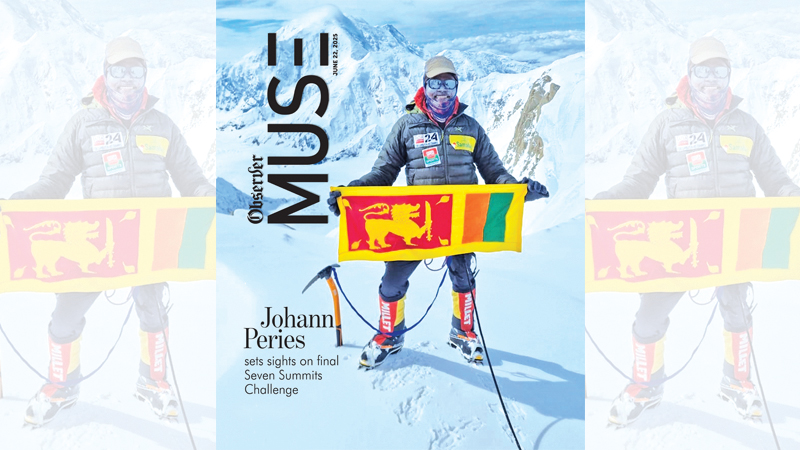Towering above all lands and kissing the thin veils of drifting clouds, mountains mesmerize with their lush greenery and enrich the pride of the landscape. Located in far-flung areas cut off from the main cities, ranges of mountains depict its both fame and centuries long history through their ruggedness.
 Mountains go down in history, carrying the dreams and teeth-clenching adventurous stories of mountaineers. Today’s piece is dedicated to one of such bravest mountaineers. He is none other than Johann Peries, who carries the pride of the Lion Flag to the highest peak in the world.
Mountains go down in history, carrying the dreams and teeth-clenching adventurous stories of mountaineers. Today’s piece is dedicated to one of such bravest mountaineers. He is none other than Johann Peries, who carries the pride of the Lion Flag to the highest peak in the world.
National pride
At a press conference, Johann shared with us his ideas and views. “This is a moment of national pride. Carrying the Sri Lankan flag to the highest points on each continent is my way of showcasing the strength, resilience, and spirit of our people.”
The event was attended by former president Ranil Wickremesinghe, who presented the national flag to Johann Peries.
Going down the memory lane, Johann recalled his childhood memories. “I studied at St. John’s College, Maradana. At that time, I was not interested in sports that much but had a passion for aesthetic subjects such as music, dancing and acting.
I have even sung songs with Marians, performed on public stages and started dancing professionally.”
After the completion of his Advanced Level studies, Johann started his career as a designer in a garment called Maxim.
Later, he wanted to explore the field of hairstyling under the guidance of giants in this field including Harris Wijesinghe, Ramani Fernando, Ramzi Rahaman. Later, He ventured into the business world as a hairstylist in 1993 by running five salons, three in Colombo, one in London, and one in Australia.
Inspired by his father, Johann embarked on a new adventurous journey of rock-climbing.
He together with his father climbed the Knuckles Mountain Ranges. When asked about his father’s inspiration, he said, “Actually, my inspiration came from my father. When I was small, he used to take me to climb mountains.

Receiving the National Flag from former President Ranil Wickremesinghe
That is how all the things started and how my journey began. But I wanted to go a step further and wanted to challenge myself. I got different challenges and I was able to bring achievements to my country because I need to prove that Sri Lankans can do anything. So, I thought of doing this for my country to carry the Sri Lankan flag to the highest position in the world.”
Step by step, Johann reaches the highest peak and delivers this message to the whole world. “We are a country that stands on our own feet. Sri Lanka is an amazingly beautiful island that you must visit.”
Going through the pages of Johann’s album, chronicling his spine-chilling rock-climbing journey, you certainly feel the sheer cliffs, the icy winds, and the heartbeat moments frozen in time. Johann came to be known as the first Sri Lankan man to summit Mount Everest, reaching the peak of almost 8,850 metres.
Certainly, you will get goosebumps, if you hear the story behind this victory. Testing his determination and stamina, there emerged an unexpected moment as he reached the summit only 400 metres away from the top of the mountain. Sadly, Johann had to turn back due to a failure of his oxygen tank. Kuru-Utumpala managed to reach the summit.
With unwavering determination and motivation, Johann summited Everest on May 22, 2018, proving that Sri Lankans are a very strong and resilient nation to the world. As noted by Johann, he had to undergo a long period of preparation and training such as climbing, swimming to achieve his goal.
Johann is no ordinary man because he has battled hardship, risen from defeat, and transcended the bounds of human limitation.
Taking the name and fame of Sri Lanka to the international arena, he has already hoisted our Sri Lankan flag in the peaks of Mount Elbrus, Mount Kilimanjaro, Mount Kosciuzko, Mount Vinson, Mount Aconcagua. Johann had attempted Denali in 2023 but unfortunately was not able to summit the mountain due to the adverse weather condition.
Seven Summits Challenge
The Seven Summits Challenge is a renowned mountaineering goal that every mountaineer dreams of. Not many but fewer mountaineers were able to achieve this goal. The Seven Summits Challenge involves climbing the highest mountain on each of the seven continents such as Mount Everest, Aconcagua, Denali (Mt. McKinley), Kilimanjaro, Elbrus, Vinson Massif and Mount Kosciuszko. No doubt that this is the greatest achievement in adventure and endurance sports. Already, Johann has conquered six of seven summits successfully.
Undoubtedly, he will let the Lion Flag flutter atop Denali this time, completing the Seven Summits Challenge and igniting new flames of hopes in our hearts.

****
Challenges

Mount Denali
Weathering icy winds, storms, and unexpected icefalls, mountaineers make great efforts to realize the dream of conquering Mount Everest. However, summiting Everest is undoubtedly a Herculean task. Though not all-inclusive, the following are some common challenges that elevate the mountaineering journey to legendary status.
Extreme Weather and Temperature
*Temperatures can drop to -40°C (-40°F) or lower.
* Sudden weather changes including blizzards and whiteouts can make climbing impossible or deadly.
* High winds can reach over 100 km/h.
Altitude and Oxygen Deficiency
* Above 8,000 metres is known as the “Death Zone” where the body starts to shut down.
* Oxygen levels at the summit are only about 33% of sea level.
* Risk of acute mountain sickness (AMS), high-altitude cerebral edema (HACE), and high-altitude pulmonary edema (HAPE).
Mental and Emotional Stress

Map of Mount Denali
As noted by Johann, he had noticed a mountaineer falling from the peak as he reached the summit. He was experiencing mental and emotional distress when his eyes witnessed it.
Health risks
* Frostbite, snow blindness, dehydration, and hypothermia are considered as the common health issues.
* Stomach illnesses and infections also can occur due to poor sanitation in camps.
Dangerous Terrain
* Icefalls (e.g., Khumbu Icefall) are unstable and can collapse unexpectedly. Hence, ladders, ropes, and crampons should be used.
* Crevasses, steep slopes, and rockfall zones present constant risks.






